My cat has diabetes: now what? (Part II)
Injections, managing absences, and handling insulin and syringes
Today’s essay concludes the two-part series on caring for a diabetic cat. You can find Part I here:
First, here are more photos of Mosi during her post-diagnosis years. The outdoor ones are from our second big vacation together in 2023 (I will write about it soon). The rest are at-home shots, mostly of her amazing mitten paws and favorite position - on my chest, hugging my neck. Sometimes she would get so close that her whiskers would tickle my nose and I would feel her warm breath. I adored it. Bonus: in the center photo, you can also see Maya snuggling on my right side.


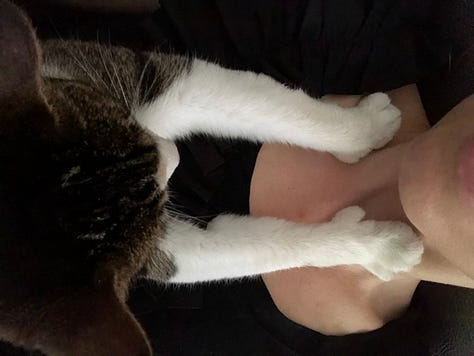
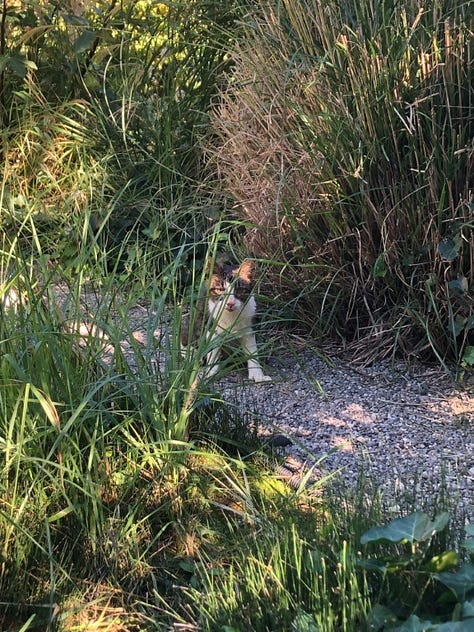
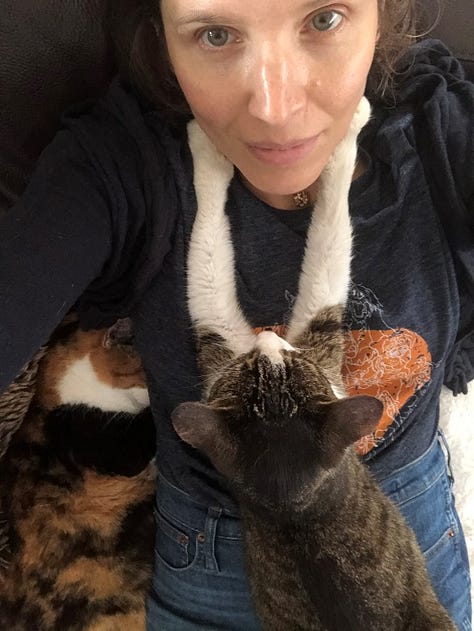
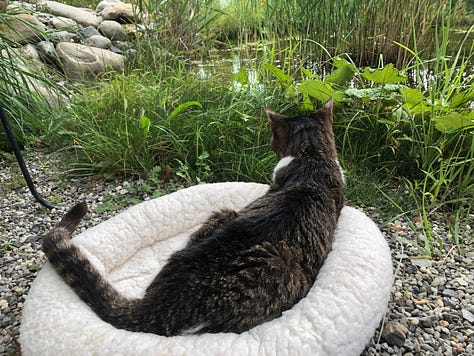
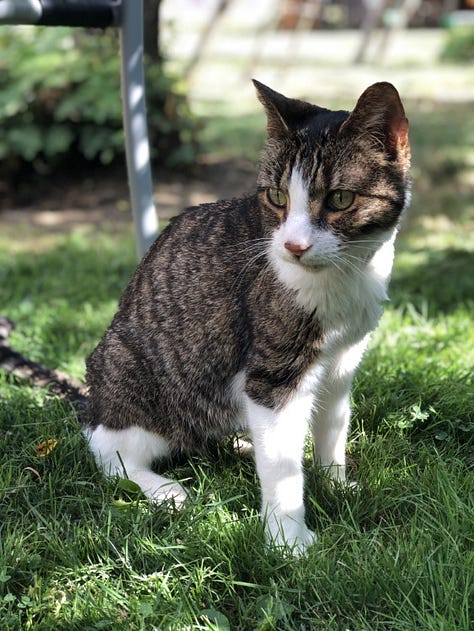
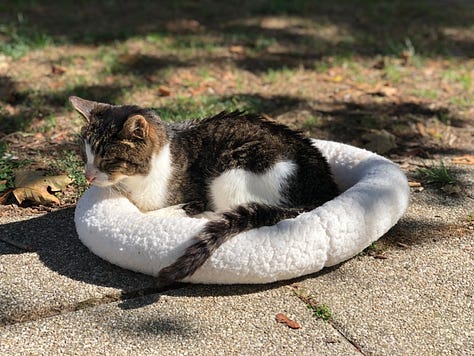
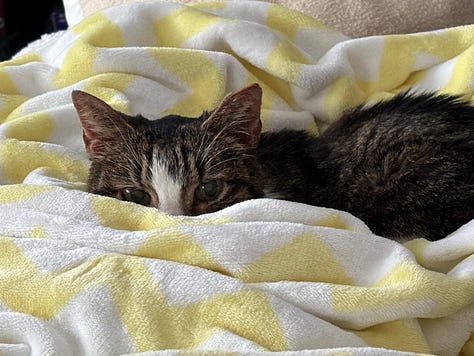
Injections: is it ever acceptable to skip?
Some sources will tell you that skipping one injection a week is acceptable. In my view, this advice is motivated primarily by the desire to decrease relinquishments or euthanasia of diabetic animals, rather than cat welfare. I scheduled absences around Mosi’s injection times or found someone to inject at the right time. I also sometimes gradually shifted injection times if I knew I would be out and had no one else to cover.
There are two scenarios in which skipping an injection is the right thing to do:
Your cat’s blood glucose is not sufficiently high: This could be because your cat is not eating as usual, has vomited, or is otherwise behaving out of the ordinary. With Mosi, it was hard to distinguish the normal-quiet from the dangerously-low-blood-sugar quiet. There is really no alternative to checking the blood sugar before injecting if you want to be sure. It can be especially important to do this if the cat will be alone for a number of hours.
You are not sure whether you injected correctly (do not double up): It is easier than you think to inject into the fur instead of under the skin, particularly if your cat has longer hair or is very thin, as Mosi became in her 21st year of life. Injecting her, something I had done hundreds of times over the previous 3.5 years, suddenly became mission impossible. I cried tears of frustration and fear, cursed myself, and searched online for hours for advice and videos of injecting a very thin cat, but came up empty-handed. All diabetic cat videos included younger, much plumper cats - there was no doubt that the medicine was going in.
One horrific week, I missed 1/3 of Mosi’s injections. I wasn’t sure whether I had done it right and didn’t dare re-inject. I took her blood sugar two hours later only to find out that the medicine did not go in correctly. As injections must follow a schedule, it wasn’t possible to simply inject then; the only solution was to wait until the next scheduled time and try again. Meanwhile, she was suffering the negative effects of hyperglycemia.1
Things improved once we shaved the fur between her shoulder blades, making the injection site visible. But the failures of the prior week weighed heavily on me. I had extreme anxiety about making a mistake. The injection process now started about 20 min before Mosi’s actual injection time. I had to breathe deeply and remind myself that I could do this. I would turn on all available lights and place Mosi carefully on a big flat pillow, positioned sitting up, back straight. I would stretch the skin between her thin shoulder blades, insert the syringe, and repeatedly palpate all around her upper chest, confirming and reconfirming that the needle tip was not protruding out of her thin body somewhere and the medicine had nowhere to go but in. Only then would I push the plunger.
Some sources will advise you to rotate the injection site to minimize local irritation. I have not had much luck with that. Injections in other areas seemed to be painful for Mosi even in her normal-weight days, and were completely impossible in her last year of life.
Carefully manage your absences
When Mosi was first diagnosed, we found a pet sitter who had previously cared for a diabetic cat and only needed a refresher. To give ourselves more flexibility, we also taught a few other pet sitters to inject. We followed a careful process. During the “meet and greet” initial interview, we ruled out anyone not prepared to come at specific set times. Those who confirmed their commitment to be on time saw one of us inject Mosi. I would then send information and a couple of good instructional videos and pay for a trial visit during which the pet sitter could inject under our supervision.
Afraid of dosing mix-ups, I would typically pre-fill syringes and leave them in the refrigerator. The pet sitter would have to remove the medicine about 5 min before injection time and gently roll the syringe between their fingers to mix the insulin and warm it so that the injection would not be painful for Mosi. I also emphasized that Mosi must have eaten well before the injection.
If in doubt as to Mosi’s behavior or appetite, the pet sitter would call me and we would decide together whether Mosi would get the full injection, half (I also left syringes pre-filled with lower doses), or nothing at all. Expecting the pet sitter to check blood glucose is not realistic. Absent a check, if the cat is not acting normally or not eating in the pet sitter’s presence, it is safer to skip an injection or give a lower dose.
Being away from her was stressful. And even when we were together, I was often concerned about injecting her based on her appetite and behavior, without a previous blood sugar check. The vet didn’t offer a better solution, but agreed that constantly checking her blood glucose (an increasingly painful process, as her ears became more sensitive over the years) wasn’t great for her welfare either.
Take care with syringes and insulin
If you look at the syringe tip carefully, you should see a bevel - i.e., a sloping part, as if the syringe end were cut at an angle. Injecting your cat with the beveled side up makes it easier for the needle to penetrate the skin and reduces discomfort (which, generally, should be minimal) (Diabetic Cat Care). It is always a good idea to lightly massage the injection site and offer a small treat. If your diabetic cat is also older, he or she may have reduced grooming due to other issues, for example, arthritis. To help with grooming and improve circulation, it is important to gently brush your cat. Diabetes makes fur brittle, so it is best to apply only light pressure and use a rubber, not metal, brush.
Insulin comes in different concentrations. Using an incorrect syringe for your insulin type can result in either insufficient injection dosage or in your cat being injected with a potentially life-threateningly high dose. Do not reuse syringes as insulin is easily contaminated.2 Used syringes should be disposed of in a sharps container available from your pharmacy.
Insulin is a volatile substance that should be handled with care. The insulin we used had to be stored in the refrigerator (not frozen) and gently rolled to mix, never shaken. When we traveled with Mosi, we brought a plug-in car cooler to keep her insulin at the right temperature. If you see any floating parts that do not disappear with mixing, discard the product. Be aware that your insulin vial may need to be discarded after a specific number of days even if there is medicine remaining. I put the expiration dates of our insulin (20 days from first use) on my calendar and made sure to have one or two new vials in the refrigerator at all times.
Trust your intuition
In the final year of life, Mosi started to lose weight. I kept bringing her to our clinic’s designated diabetes specialist, who kept advising that we increase the insulin dose. This caused Mosi’s sugar to drop below normal. The specialist also said that blood work isn’t necessary as it wouldn’t change the treatment plan.
Mosi also sometimes had diarrhea in her final months of life. I was using the Pet Diabetes app to track her symptoms. After a few ‘diarrhea’ entries, the app flashed a warning: “take your cat to the vet.” This time, I made an appointment with our generalist vet. After examining Mosi and hearing about her symptoms, he was sure that the problem was unrelated to diabetes. Blood tests showed that he was right. We could only treat some of the problems due to Mosi’s age and frailty. We started a new protocol and Mosi finally began to stabilize. We got to share five more miraculous months.
All this to say: you know your cat better than anyone else. Trust your intuition and, if in doubt, get a second opinion without delay.
This essay has been reviewed for accuracy by a veterinary professional, but I am not a vet and each cat’s situation is unique. For questions about your diabetic cat’s health, please check with your vet.
Have you ever cared for a diabetic cat or know someone who has? Would you like to hear more about diabetic cat care?
If you are interested in a broad range of content on cat care, the human-cat relationship, cats in the arts, and more, check out Minding Mittens. I write about cat loss grief on Letters to Mosi.
If you’d like to support my work, you have the option of doing so here:
We’ve never had to deal with diabetic ketoacidosis, a life-threatening emergency caused by uncontrolled high blood sugar, but it was always on my mind.
We did reuse syringes for a while, as the vet told us it would be fine to use each syringe twice. Then I read up about insulin being a sensitive substance and immediately stopped the re-use. I didn’t want to take any risks with Mosi and blamed myself for not having been more careful and diligent in researching this issue earlier, the vet’s opinion notwithstanding. I was comforted when I found recent research relating to syringe re-use in humans with type II diabetes (which is most similar to feline diabetes mellitus), suggesting that needle reuse does not affect glycemic control, which was my biggest concern. Berlanda, G. et al. (2024) Impact of Syringe and Needle Reuse on the Clinical Outcomes of Patients With Type 2 Diabetes: A 12-Week Randomized Clinical Trial. Diabetes Care 47 (12): 2146–2154. https://doi.org/10.2337/dc24-0157.






You took such a great care of her! Mosi was lucky to have you ❤️
Such dedication and love for sweet little Mosi. ❤️ It shows.